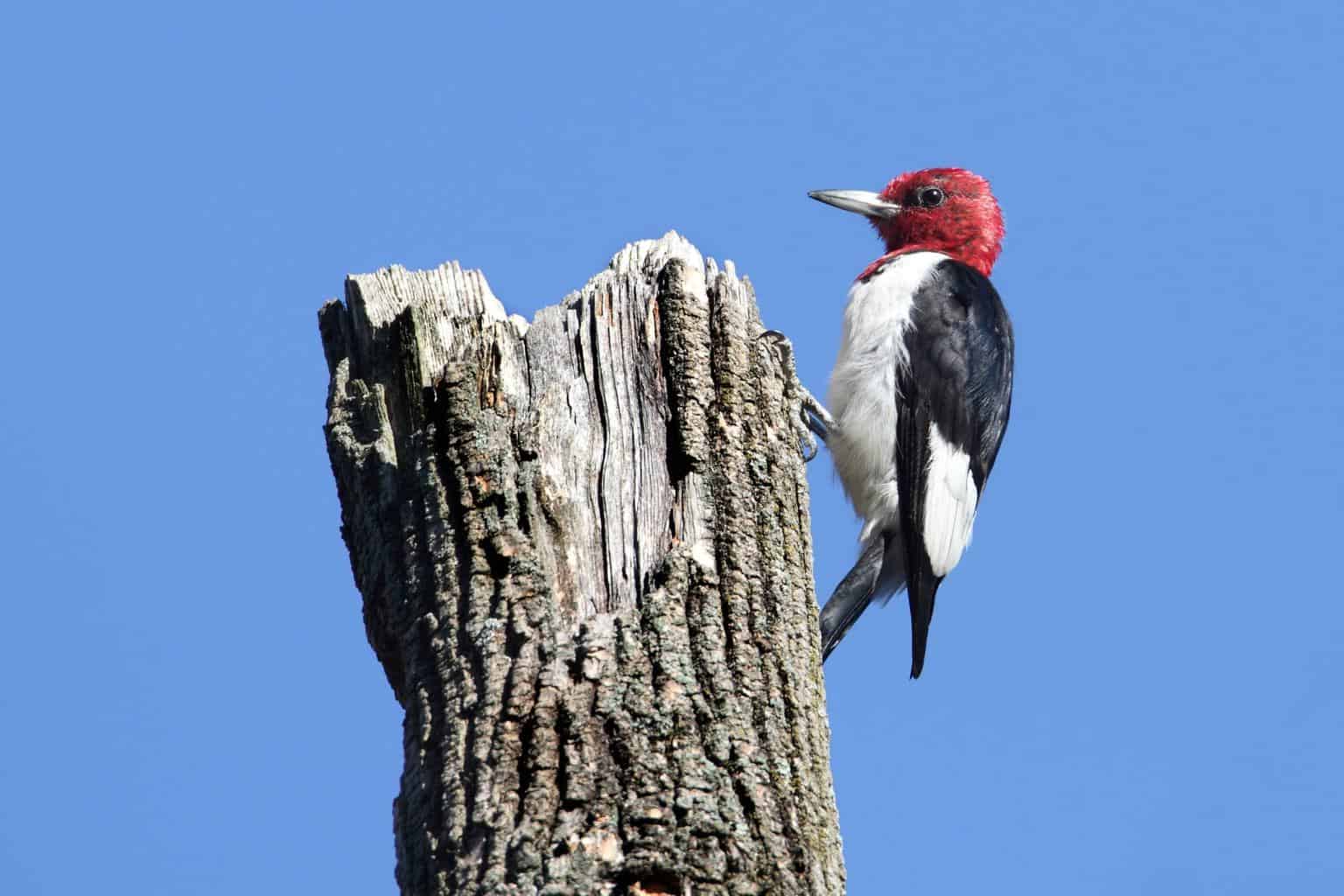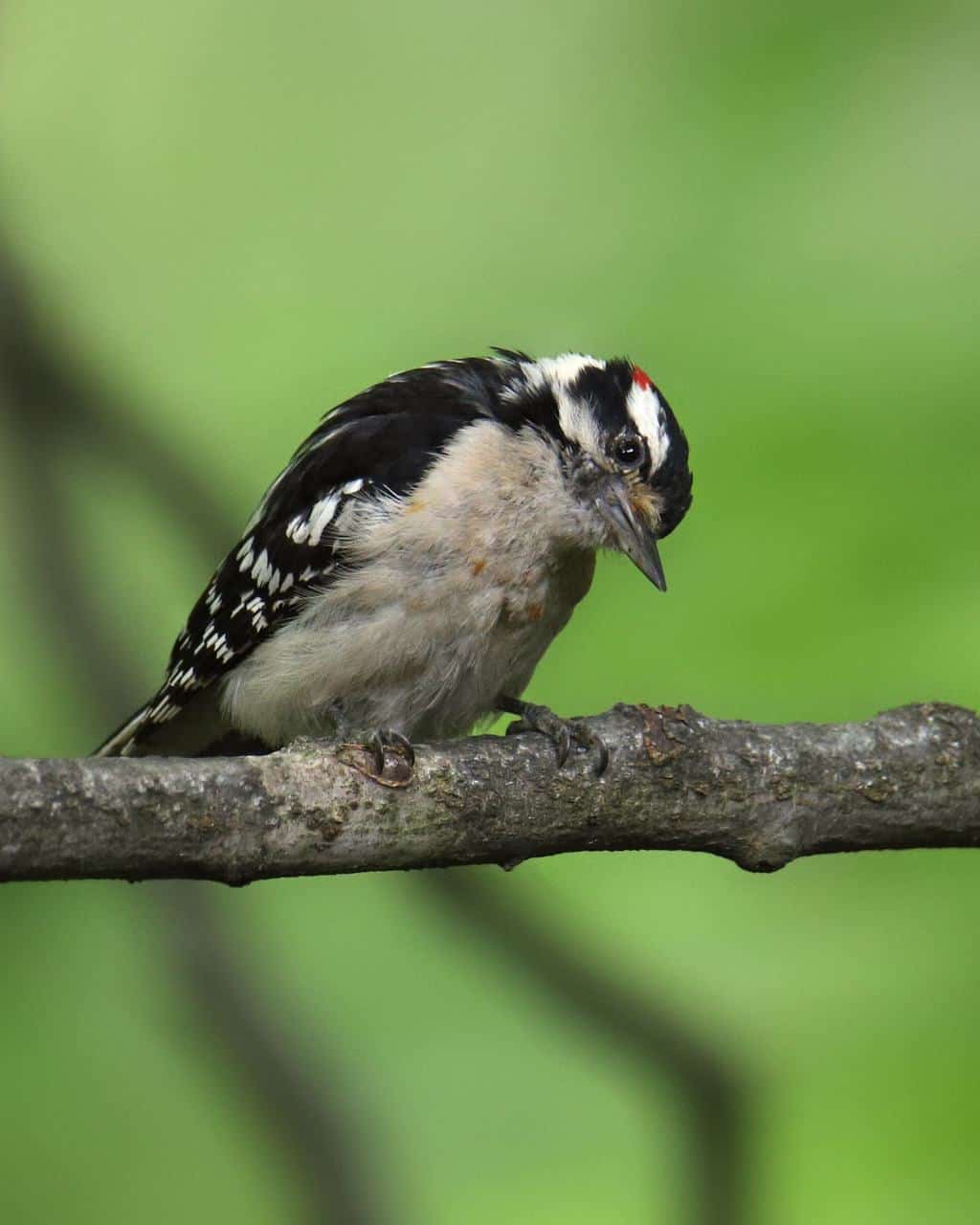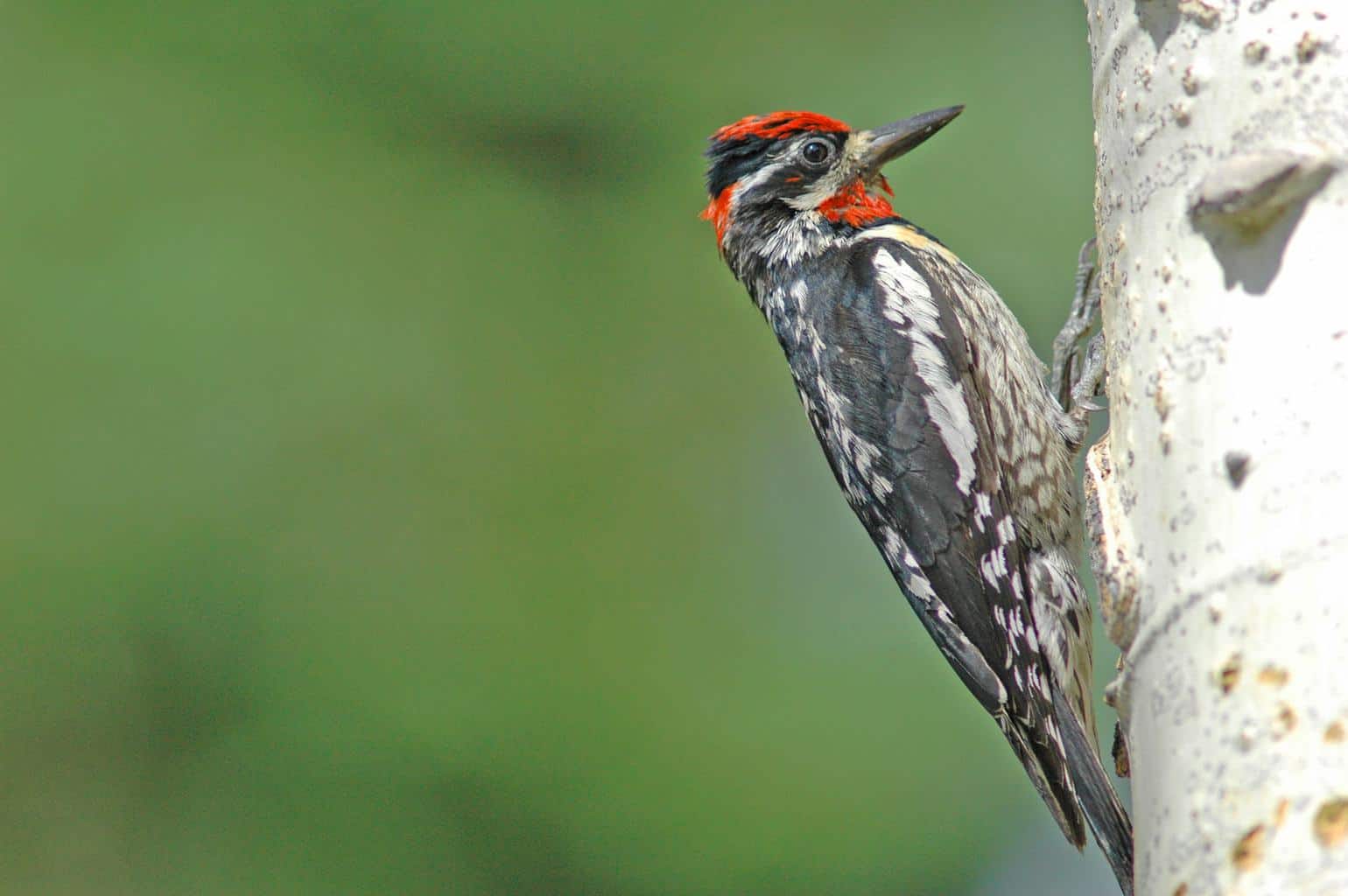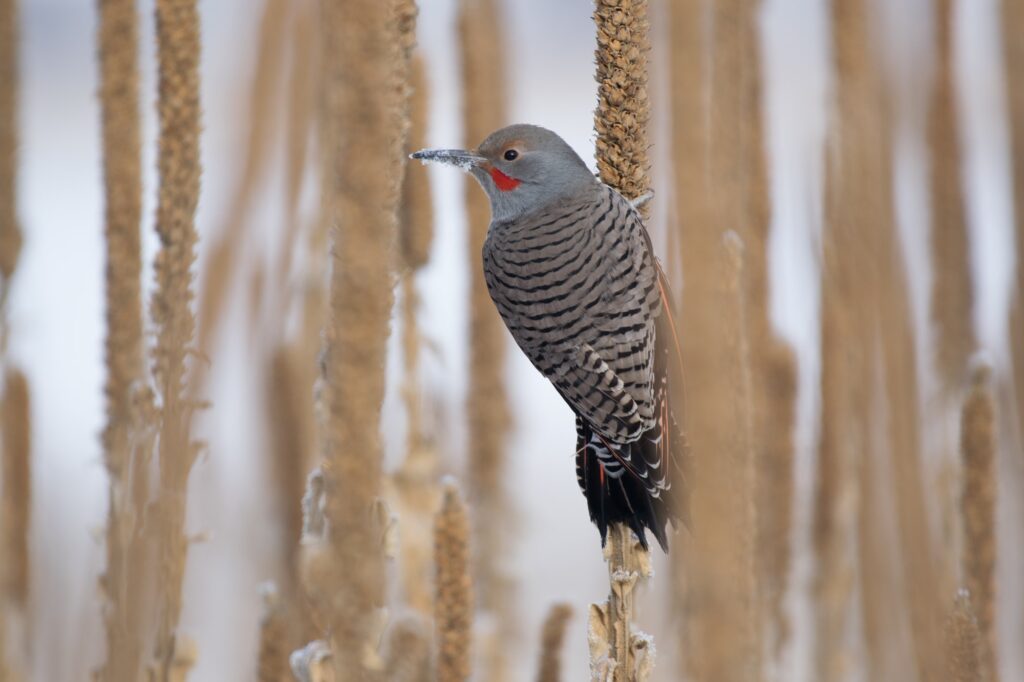It’s quite common to hear the famous knocking on trees if you’re spending time in Alabama. This is normal, as Alabama is home to 8 species of woodpeckers among other 446 species of birds.
In addition to the interesting museums and water parks, there are a lot of botanical gardens where you can find woodpeckers in Alabama.
As a matter of fact, the Northern Flicker is actually the state bird of Alabama, so it’s likely to see this bird flying in backyards for suet and seeds.
In this article, we’ll talk about the different types of woodpeckers in Alabama.
Northern Flicker

Scientific Name
Colaptes Auratus.
Length
Between 11 and 14 inches.
Weight
Between 3 and 5.9 ounces.
Wingspan
Between 17 and 21 inches.
Additional Information
The Common Flicker or the Northern Flicker is a relatively large woodpecker with a slightly curved bill.
The birds are known for their beige brownish bodies with distinctive black markings on the back and wings. There are black spots covering the body.
The feathers on the underside of wings and tail can be red or yellow, depending on where the bird is coming from and the type of food it eats. The Yellow-Shafted Northern Flicker is the only one found in Alabama.
The Northern Flicker prefers to dig through horizontal branches, fallen logs, or the ground. When it’s not feeding on insects, the bird will feed on vegetable and plant matter.
It likes to search for ant larvae by sticking its long tongue into ant colonies. It also protects crops from damage as it feeds on various pests.
Birds like to drum on trees or metal objects to mark their territories, and in case of danger, they would try to make as much noise as possible.
The Northern Flicker is easy to see in Alabama as it flies next to residential areas, in parks, and around swamps.
Red-Headed Woodpecker

Scientific Name
Melanerpes Erythrocephalus.
Length
Between 7.5 and 9.8 inches.
Weight
Between 2 and 3.4 ounces.
Wingspan
About 16.7 inches.
Additional Information
As the name suggests, this bird has a strikingly bright red head. It also has a black back and a white belly.
Younger birds usually have gray heads that turn red when they reach adulthood.
The Red-Headed Woodpecker is a medium-sized bird with a robust spike-like bill to penetrate through trees’ bark to feed on larvae.
The bird flies to catch the insects flying in the air or forage on trees like other woodpeckers. It feeds on nuts, seeds, grapes, berries, and even small rodents and other younger birds, which is a bit unusual for woodpeckers.
Although this bird was considered Near Threatened, the management of its habitat and preservation of trees helped increase its population. It competes with other cavity nesters like European Starlings or Red-Bellied Woodpeckers for dead trees to build nests.
Red-Cockaded Woodpecker

Scientific Name
Dryobates Borealis.
Length
Between 7.1 and 9.1 inches.
Weight
Between 1.4 and 2 ounces.
Wingspan
Between 13 and 16 inches.
Additional Information
The Red-Cockaded Woodpecker has a black back with white stripes and a back cap and nape, with red feathers that appear on the cap’s sides during the mating season. These red streaks are exclusively found in males and might be challenging to find.
Unlike other types of woodpeckers, it prefers old live pine trees that are affected by heart rot. It likes to dig through the softened bark to look for beetle larvae, centipedes, and wood roaches and might also feed on grains, wild cherries, nuts, and black gum berries.
The Red-Cockaded Woodpeckers are currently listed as Near Threatened due to loss of habitat. The birds also compete with the Red-Bellied Woodpeckers for nesting cavities.
The nest cavity follows the contour of the rot in the tree. The bird will also dig holes that leak tree pitch to keep predators away from the nest.
Younger males usually stay with the family to help take care of younger birds.
Red-Bellied Woodpecker

Scientific Name
Melanerpes Carolinus.
Length
Between 9 to 10.5 inches.
Weight
Between 2 and 3.2 ounces.
Wingspan
Between 15 and 18 inches.
Additional Information
The Red-Bellied Woodpecker looks close to the Red-Headed Woodpecker but is more common to find. It has a barred back and a bright red cap that makes it easy to recognize.
It manages to catch the larvae in the crevices of dead trees using its sticky spit and its barbed-tip tongue that sticks 2 inches past the end of the beak. It likes to feed on spiders, larvae, acorns, nuts, seeds, pine cones, lizards, and nestling birds.
This bird will hide nut in crevices of trees, then break them into smaller pieces. It will also hide food for later use.
The Red-Bellied Woodpecker might take other birds’ nests like the less common to find the Red-Cockaded Woodpecker. However, this bird is usually attacked by the European Starling.
It might visit bird feeders when food is rare to find.
Yellow-Bellied Sapsucker

Scientific Name
Sphyrapicus Varius.
Length
Between 7.5 and 8.3 inches.
Weight
Between 1.2 and 2.2 ounces.
Wingspan
Between 13.4 and 15.8 inches.
Additional Information
Males and females of the Yellow-Bellied Sapsucker are differentiated by the color of the forehead and throat. The forehead is red or yellow in males and is a light shade of red in females, while the throat is red in males and white in females.
This bird digs shallow and deep sap wells in trees to lick the trees’ sugary sap and cambium and feed on any insects that might be found inside. These sap wells attract other types of birds and animals that feed on the sap.
It’s easy to find this bird if you can find the organized sap wells, which the bird usually digs on top of each other.
The Yellow-Bellied Sapsucker has a strong bill that it uses to drum on trees and man-made objects. The metal objects amplify the territorial drumming, and the bird will usually visit its favorite signs.
Although this bird isn’t a regular visitor to bird feeders, it might get attracted to your suet bird feeder in winter when food is scarce.
Pileated Woodpecker

Scientific Name
Dryocopus Pileatus.
Length
Between 16 and 19 inches.
Weight
Between 9 and 14 ounces.
Wingspan
Between 26 and 30 inches.
Additional Information
This rather large woodpecker has a white-striped black back and a bright red crest. Woody Woodpecker, the famous cartoon character, is a Pileated Woodpecker.
This bird likes to feed on carpenter ants and will dig rectangular holes in the wood of trees to look for them. It also likes to feed on wood-boring beetle larvae, caterpillars, grasshoppers, and spruce budworms.
Other birds, like the Hairy Woodpecker, will come feed on the insects left in the excavations left by this bird.
Unlike other types of woodpeckers, this one is highly adaptable as it managed to survive the human habitation of its habitat. When food is scarce, it might visit your backyard if you have a bird feeder.
Downy Woodpecker

Scientific Name
Dryobates Pubescens.
Length
Between 5.5 and 7.1 inches.
Weight
Between 0.71 and 1.16 ounces.
Wingspan
Between 9.8 and 12.2 inches.
Additional Information
The Downy Woodpecker is between the sizes of a robin and a sparrow, so it’s one of the smallest woodpeckers. It has a distinctive black body with a bright white back, belly, and throat, in addition to small white spots on the wings.
The head is striped, giving an overall checkered impression.
When males reach adulthood, they grow a bright red patch on the back of the head.
In the springtime, you would be able to recognize the presence of the Downy Woodpecker as it keeps on calling other birds and drums on trees. You can easily see this bird among orchards, backyards, and parks, where it will find trees to dig nests and look for larvae.
It’s characterized by its quick movement among tree branches. In some cases, you can see the Downy Woodpecker in open areas, nesting along fencerows.
Just like other woodpeckers, it feeds on beetle larvae that live inside trees. It also likes to eat ants, caterpillars, and dangerous crop pests.
When food is scarce, the bird will feed on vegetables and plants. It can feed on grains, acorns, and wild berries that grow on trees.
Because it doesn’t mind visiting backyards, it’s common to see the Downy Woodpecker feeding on suet and drinking water from hummingbird feeders.
Hairy Woodpecker

Scientific Name
Leuconotopicus Villosus.
Length
Between 7 and 10.2 inches.
Weight
Between 1.4 and 3.4 ounces.
Wingspan
Between 13 and 17 inches.
Additional Information
The Hairy Woodpecker is slightly larger than its look-alike, the Downy Woodpecker. It also has a louder and more attention-grabbing call.
This bird spends most of its time following the Pileated Woodpecker, examining the holes excavated by the latter to pick up any left beetle larvae or ants.
It’s also attracted to the sap wells dug by the Yellow-Bellied Sapsucker to lick the sugar sap. The bird might even pick into sugar cane for the sugary juice.
The Hairy Woodpecker likes to nest in living trees if they’re infected by heart rot. The entrance of the nest is on the underside to protect the bird and the eggs from predators.
This bird will visit your backyard in winter if you have suet or black oil sunflower seeds in your bird feeder.
Conclusion
Seeing woodpeckers is common in Alabama, as there are lots of parks and trees where the birds would look for larvae. These birds dig through the trees’ bark and might occasionally forage the ground to find more larvae.
When food is scarce, the birds can feed on plants and animals. However, they’re usually prized because they feed on dangerous crop pests.
Pay attention to the woodpeckers’ drumming, and you will see these incredible birds in their natural habitat.











